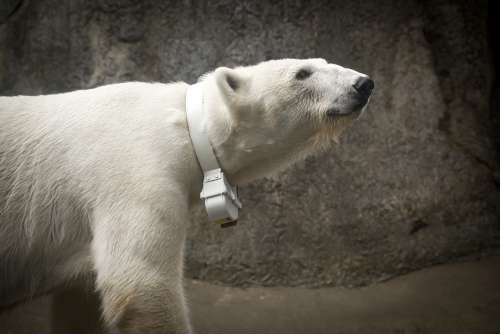"Direct behavioral observations are nearly impossible," says Amy Cutting, Oregon Zoo curator.
Enter Tasul, an Oregon Zoo polar bear, who is now wearing a high-tech collar to help get some climate change answers. Within the collar is an accelerometer, like the one found in most smart phones the NSA is monitoring you with, and it detects minute changes in motion and direction of movement.
The device turns Tasul’s everyday behaviors like walking, eating, sleeping and swimming into electronic signals. By recording video of her wearing the collar and matching the behavior to the signal, researchers will create a sort of digital fingerprint for polar bear behavior. Once the signals are calibrated, similar collars can be placed on free-roaming bears in the Arctic, allowing researchers to monitor their behavior without having to observe them directly.
The collars will be equipped with quick-release mechanisms so scientists can open them remotely - without a tranquilizer gun, it is a bad idea to get too close - and let them drop off the bears after the necessary data has been obtained.

Tasul, an Oregon Zoo polar bear, with an accelerometer collar. Photo by Michael Durham, courtesy of the Oregon Zoo.
"Our research shows that polar bears are being displaced from sea ice habitats they formerly used," said Anthony Pagano, a wildlife biologist with the USGS Alaska Science Center. "This collaborative project with the Oregon Zoo will help us understand the implications between going to land or staying with the ice as it retreats hundreds of kilometers north into the Arctic Basin."
To train Tasul to wear her "techcessory," keepers slowly acclimated the bear to different types of neckwear over several months, using a special training module that allows close — but safe — access. Zoo visitors may see Tasul wearing the collar periodically throughout the summer.
"Tasul was the perfect candidate for this study because she already participates in many health-care behaviors voluntarily, as opposed to requiring tranquilization," Cutting said. "She doesn’t mind wearing the collar and actively cooperates. She is a very curious bear and seems interested in all the extra attention from keepers."
The training sessions also gave zoo staffers a chance to get a bear's-eye view of Tasul's daily activities by attaching a small GoPro camera to her training collar. Footage from the "Tasul-cam," is available on the Oregon Zoo website. Here's some first person footage. This looks like a pretty good video game.
"There's a lot we need to learn about how climate change is affecting polar bears,” Cutting said, "so it's very rewarding to see Tasul offering researchers a chance to study this threatened species in a new way."
This project is part of the U.S. Geological Survey's Changing Arctic Ecosystems initiative, which includes research on the effects of climate change on polar bears.





Comments